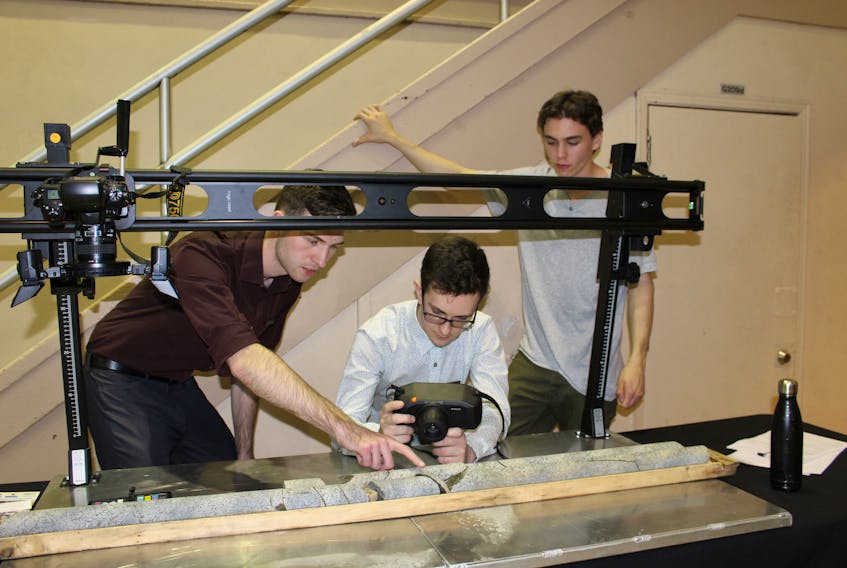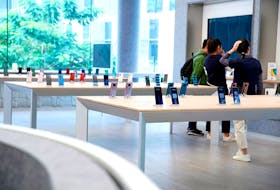What started out as a conversation may just lead to a business venture for three students at the College of the North Atlantic (CNA) Prince Philip Campus.
The students — Jacob Manning, Mason Gulliver and Cole Inkpen — had a conversation with Gary Thompson, a registered professional geoscientist who works in the Office of Applied Research at CNA, about the potential and need for photographing the core library of the approximately three million metres of drill core stored at a variety of locations across Newfoundland and Labrador.
In addition, the students got a push in the right direction by their photography instructor Ray Fennelly, whom they credit with bringing the three students together for the project.
“He told us, ‘You know how to do this, so why not take a look at it. The three of you could go into business together and make this happen,”’ Manning said.
So, the conversation started among the three students and a plan was hatched, and they are currently working on their company and making pitches to document the core samples in the province. There is possible work within the government on new mining prospects, and perhaps an opportunity to branch out to other jurisdictions in the future.
“I think we can take a run at this for quite a while,” Inkpen said.
As photography students, they looked at what device would best suit their needs and they decided on the Specim IQ. Its use opens up plenty of new possibilities for hyperspectral imaging, both in the existing as well as in totally new application fields.
Because everything in the world has its own unique light signature, it makes it difficult to see more than three colours (blue, red and green) with the human eye. This process with the Specim IQ works like bees, which have four colour receptors, allowing them to distinguish 100 million colours — 10 times that of humans.
Hyperspectral imagers were created to allow us to see billions of colours, letting us know the full composition of what we are viewing.
In the past, these machines were large and cumbersome, and limited to laboratories where samples were sent for characterization.
Specim, the world’s first portable hyperspectral camera — the Specim IQ — changed that by providing instant hyperspectral imaging.
“The hyperspectral camera we are using in not widely used. This is the first mobile one here and it can have a host of uses.” Manning said.
“It can be used in food service, the medical/pharmaceutical community or art history. It has a broad range of uses.”
Gulliver joked that the giodata plan to preserve these samples is quite literally core technology.
“The management, preparation and lighting is key to getting high-quality photos that will help geologists,” he said.
“We are sitting on really valuable data here that has to be preserved.”
To put in perspective the vast amount of core samples being stored across the province, Manning said, Nova Scotia has 750,000 metres and New Brunswick just over 650,000, making the cataloging of samples here a huge task, but a necessary one, as eventually they will break down and not be an accurate representation of the area they were taken from.
“We are going to do a test run of some samples in Labrador soon,” Inkpen said.
“Our first goal will be to document all the samples across the province to preserve them and make the data available to companies seeking to drill here,” Gulliver added.
Only half of the inventory is being controlled at present by the Department of Mines and Energy. Thus, companies looking to start new drilling in a variety of areas around the province first have to look at old core samples.
The work giodata does would allow the companies to do this efficiently and remotely. The images could be uploaded to the cloud and anyone around the world would be able to view high-resolution images and magnify them up to 15 times for better viewing.
“We have to care for and document these samples. We can’t afford to lose that data,” Manning said.
“Our giodata scanner is faster, smarter and more secure than other options out there right now. It is modern, fluid and mobile,” he said.
The College of the North Atlantic’s Innovation at Work! Event, held Tuesday at the Prince Philip Campus, was a day-long innovation showcase that highlighted projects and applied research and development being carried out at CNA.
More information on the camera being used by giodata can be found online at www.specim.fi/iq/.









